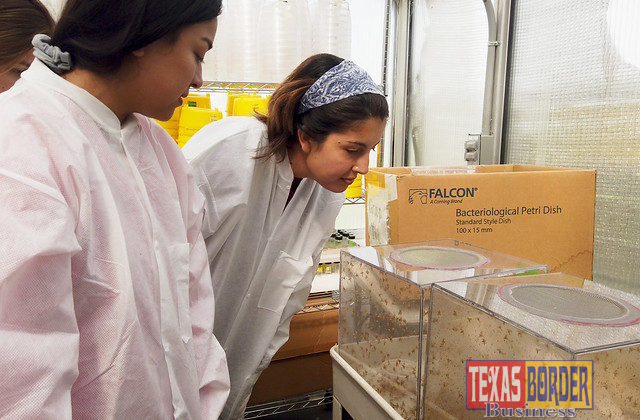
Workshops invite local teachers into Valley agricultural research, show career opportunities
Texas Border Business
By Maria Elena Hernandez
JULY 2019– Science teachers from 15 school districts in the Rio Grande Valley will head back to their classrooms this fall with new curriculum, courtesy of the UTRGV Agroecology Professional Development Institute.
“It’s a four-week workshop where we host a number of teachers from across the Valley and expose them to research and careers in agriculture,” said Dr. Alexis Racelis, a UTRGV assistant professor of agroecology.
Racelis leads the professional development program, along with UTRGV master science teacher Tim Sears.
“What we found in previous workshops is that teachers often have a misconception about what it means to have a career in agriculture,” Racelis said. “Often, they think of farmers and laborers. And rarely do they think of entomologists, cell biologists, geneticists and ag specialists.”
FIELD TRIPS, LABS FOR TEACHERS
Each Friday in June, the group of 24science teachers took morning field trips, which included visits to the Texas A&M-Kingsville Citrus Center in Weslaco and the USDA research facility at Moore Air Base in Western Hidalgo County. In the afternoons, they headed to the UTRGV Edinburg Campus for curriculum development workshops.
Yaquelín Helms, a teacher at Pace Early College High School in Brownsville, participated in the professional development institute and will be teaching AP environmental science this coming school year.
“I want to learn as much as I can, so then I can take it back to my students,” she said.
The high school science teacher said she hadn’t been familiar with the scientific work happening locally, but is glad to know now.
“It’s amazing research, and you don’t think it happens in the Valley,” she said. “It’s amazing to know that it does.”
LOCAL AGRICULTURAL RESEARCHERS
Dr. Evan Braswell, a biological scientist at the USDA facility at Moore Air Base, said agriculture is a field that uses every branch of science, from physics to chemistry to biology to engineering.
“It’s an applied field that uses every scientific tool that we can to solve problems,” he said.
Braswell led one of the teacher groups who toured the USDA facility.
“It’s fun for us to bring in these teachers,” he said. “We hope it has an impact in their classrooms and brings students into the sciences and into agriculture.”
PARTICIPANT FEEDBACK
Sears, the UTRGV Science Master Teacher, said area science and ag science teachers too often don’t have opportunities for professional development related to science and agricultural science.
“So we’re excited to be able offer this to them locally,” he said. “Some of the feedback we’ve received from our teacher participants has been that they’ve never before been to the sites we’ve taken them to. So we’ve exposed them to local research in the area – local farms, and local organic farms involving agricultural research – so they can take those locally relevant examples back to the students they teach in high schools.”
GRANTS AND OTHER POSSIBILITIES
Helms, the Pace Early College High School teacher, called the professional development institute a great opportunity that can help introduce teachers to more ways to expand their knowledge.
“They talk about all these grants – not only for students, but for teachers – that I didn’t even know about. So it opens up doors,” she said.
The APDI itself is funded by a grant awarded to UTRGV earlier this year. The National Institute of Food and Agriculture, a part of the USDA, awarded almost $150,000 to the university for the three-year program.













